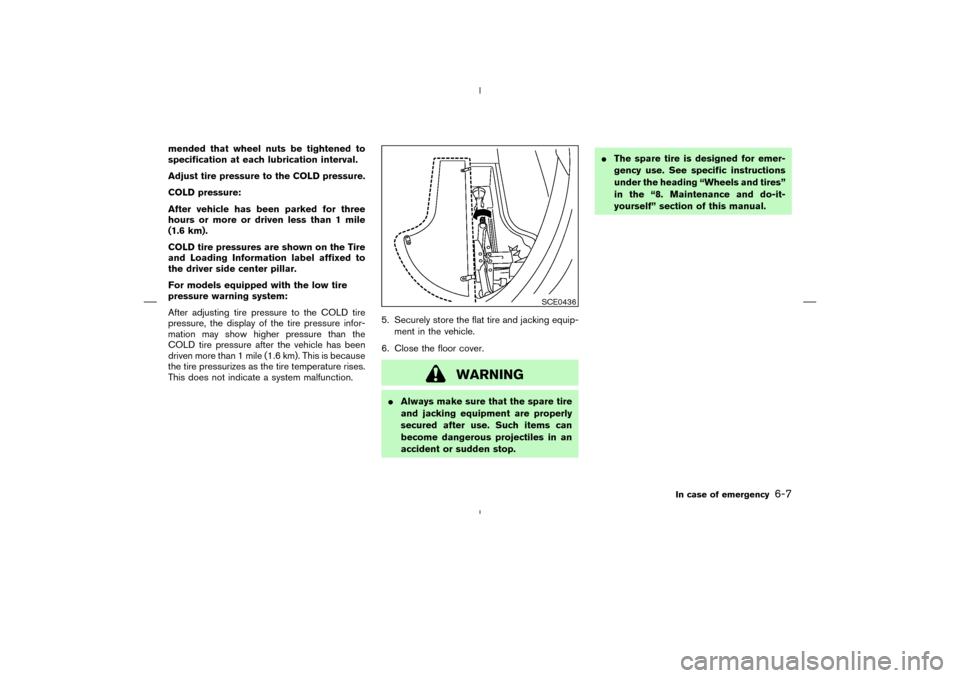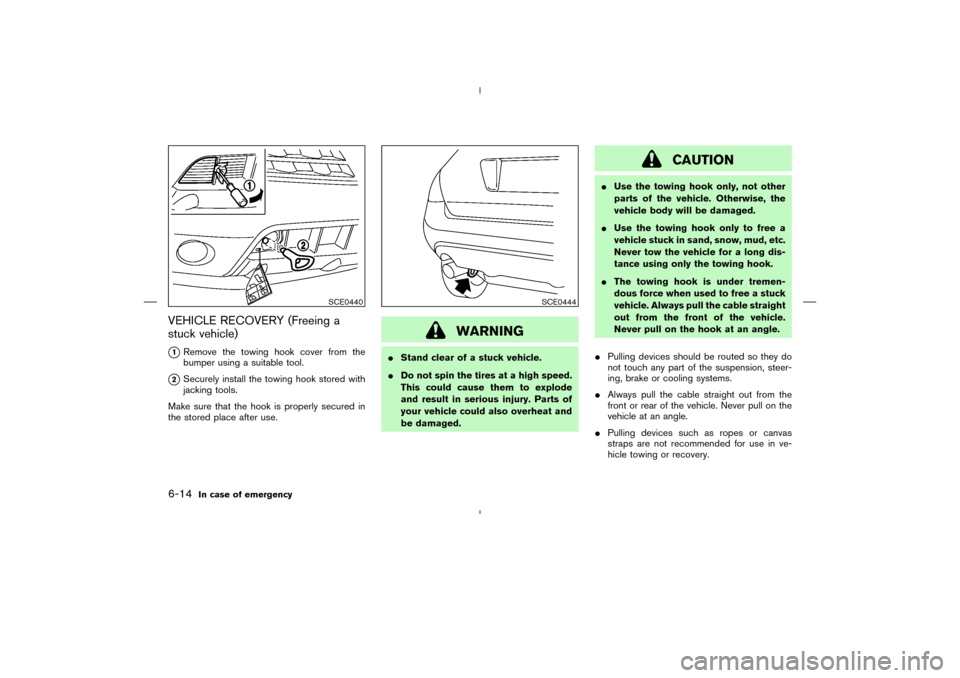Page 194 of 283

Jacking up vehicle and removing the
damaged tireCarefully read the caution label attached to
the jack body and the following instruc-
tions.
1. Place the jack directly under the jack-up point
as illustrated above so that top of the jack
contacts the vehicle at the jack up point.
Align the jack head between the two notches
in the front or the rear as shown. Also fit the
groove of the jack head between the notches
as shown.The jack should be used on level firm
ground.
2. Loosen each wheel nut one or two turns by
turning counterclockwise with the wheel nut
wrench.Do not remove the wheel nuts
until the tire is off the ground.
3. Carefully raise the vehicle until the tire clears
the ground. To lift the vehicle, securely hold
the jack lever and rod with both hands as
shown above. Remove the wheel nuts, and
then remove the tire.
WARNING
�Never get under the vehicle while it is
supported only by the jack.
�Use only the jack provided with your
vehicle to lift the vehicle. Do not use
the jack provided with your vehicle
on other vehicles.
The jack is designed only for lifting
your vehicle during a tire change.
SCE0435
CE1092
In case of emergency
6-5
�
04.4.5/Z50-D/V5.0
�
Page 196 of 283

mended that wheel nuts be tightened to
specification at each lubrication interval.
Adjust tire pressure to the COLD pressure.
COLD pressure:
After vehicle has been parked for three
hours or more or driven less than 1 mile
(1.6 km).
COLD tire pressures are shown on the Tire
and Loading Information label affixed to
the driver side center pillar.
For models equipped with the low tire
pressure warning system:
After adjusting tire pressure to the COLD tire
pressure, the display of the tire pressure infor-
mation may show higher pressure than the
COLD tire pressure after the vehicle has been
driven more than 1 mile (1.6 km). This is because
the tire pressurizes as the tire temperature rises.
This does not indicate a system malfunction.5. Securely store the flat tire and jacking equip-
ment in the vehicle.
6. Close the floor cover.
WARNING
�Always make sure that the spare tire
and jacking equipment are properly
secured after use. Such items can
become dangerous projectiles in an
accident or sudden stop.�The spare tire is designed for emer-
gency use. See specific instructions
under the heading “Wheels and tires”
in the “8. Maintenance and do-it-
yourself” section of this manual.
SCE0436
In case of emergency
6-7
�
04.4.5/Z50-D/V5.0
�
Page 203 of 283

VEHICLE RECOVERY (Freeing a
stuck vehicle)
�1Remove the towing hook cover from the
bumper using a suitable tool.
�2Securely install the towing hook stored with
jacking tools.
Make sure that the hook is properly secured in
the stored place after use.
WARNING
�Stand clear of a stuck vehicle.
�Do not spin the tires at a high speed.
This could cause them to explode
and result in serious injury. Parts of
your vehicle could also overheat and
be damaged.
CAUTION
�Use the towing hook only, not other
parts of the vehicle. Otherwise, the
vehicle body will be damaged.
�Use the towing hook only to free a
vehicle stuck in sand, snow, mud, etc.
Never tow the vehicle for a long dis-
tance using only the towing hook.
�The towing hook is under tremen-
dous force when used to free a stuck
vehicle. Always pull the cable straight
out from the front of the vehicle.
Never pull on the hook at an angle.
�Pulling devices should be routed so they do
not touch any part of the suspension, steer-
ing, brake or cooling systems.
�Always pull the cable straight out from the
front or rear of the vehicle. Never pull on the
vehicle at an angle.
�Pulling devices such as ropes or canvas
straps are not recommended for use in ve-
hicle towing or recovery.
SCE0440
SCE0444
6-14
In case of emergency
�
04.4.5/Z50-D/V5.0
�